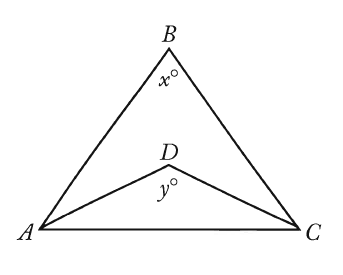russ9 wrote:
Bunuel wrote:
 In the figure above, what is the value of x + y ?
In the figure above, what is the value of x + y ?(1) x = 70.
(2) ABC and ADC are both isosceles triangles.
Even when we consider both statements together we don't know the placement of points D and B. For example consider the diagram below:
Attachment:
Triangles2.png
As you can see we can have two different answers for x+y for two different placements of point D.
Answer: E.
Hi Bunuel,
If they had provided us additional information as such: AB=BC, AD=AC and ADC = 1/2 height of ABC. If that's the case, can we use the same inscribed angle rules we use for circle - can we assume that Y would've been 2x, therefore 140 degrees?
Would the answer change if AB & BC weren't equal and AD & AC weren't equal?
Thanks
Dear
russ9,
I'm happy to answer this.

If we knew AB=BC and AD=AC, then we would know the triangles were isosceles, which would have added a tremendous amount of useful information to the problem.
Your application of the inscribed angle rule, unfortunately, is 100% incorrect. Among other things, if triangle ABC were inscribed in a circle, the center of that circle would
NOT lie on side AC. If ADC = 1/2 height of ABC, then that would
NOT mean that AD bisected angle BAC or that CD bisected angle BCA. If we had been told that those two segments were angle bisectors, then yes, it would have been true that y = 140.
Here's a real paradox: if we had been told the three pieces of information you suggested, those would uniquely determine triangle ADC, such that all of its angles would be mathematically determined. To find the measure of y would involves some sophisticated trigonometry and a calculator --- finding the numerical value of y would be well beyond anything the GMAT could expect you to do, but technically, y would be mathematically determined and one
could find it, which means that information would be sufficient. In practice, the GMAT doesn't put you in that position --- it doesn't expect you to find as sufficient something that is uniquely determined mathematically but incalculable using ordinary GMAT math. The GMAT will only put you in the position of declaring something sufficient if you realistically could find it with ordinary GMAT math.
Does all this make sense?
Mike




 35%
(medium)
35%
(medium)
 31%
(01:23)
wrong
31%
(01:23)
wrong  based on 3550
sessions
based on 3550
sessions




